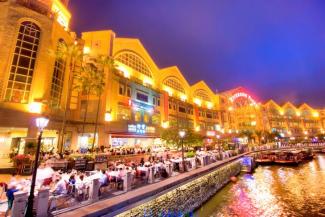
[Singapore, 25 November 2014 (Tuesday)] – The Institute of Service Excellence at the Singapore Management University (ISES) (卓越服务研究院) released the 2014 third quarter (Q3) Customer Satisfaction Index of Singapore (CSISG) results for the Food & Beverage (F&B) and Tourism sectors today.
Between 2013 and 2014, customer satisfaction for the F&B sector fell 4.56-points (-6.5%) to 65.8-points (on a 0 to 100 scale). The Tourism sector also registered a similarly significant decline in customer satisfaction, falling 5.44-points (-7.3%) to 69.1-points.
Ms Caroline Lim (林晓玲), ISES Director (总监) said, “These lower scores could be a case of correction as companies transition to new business models, with consumers taking time to adapt to new norms in how service is delivered and experienced.”
While three of the five measured sub-sectors in F&B performed on par with the previous year’s scores, the decline in customer satisfaction at the Restaurants sub-sector, falling 7.51-points (-10.5%) to 64.1-points, and Cafes & Snack Bars sub-sector, falling 4.87-points (-6.8%) to 66.2-points, pulled down the overall F&B sector score.
The other three F&B sub-sectors, namely Bars & Pubs, Food Courts, and Fast Food Restaurants, scored 70.0-points (-0.59-points/-0.8%), 66.1-points (+0.58-points/+0.9%), and 69.0-points (+1.06-points/+1.6%), respectively.
The decrease in the Restaurants and Cafes & Snack Bars sub-sectors was due largely to significantly less satisfied tourist customers. In fact, they gave lower ratings to all five F&B sub-sectors measured in the survey.
Bearing the brunt of the decline in tourist satisfaction for the F&B sector was the Restaurants sub-sector. Further analysis revealed that tourists gave poorer year-on-year ratings in all nine of the restaurant touchpoints the CSISG survey measured. This included touchpoints that had a significant impact on tourists’ perceptions of quality, such as bill timeliness and accuracy, cleanliness, food quality, ease of reservation, and the time taken to receive food. In contrast, local customers indicated improved restaurant touchpoints compared to 2013.
Assistant Professor of Marketing (Practice) Marcus Lee (李德发), Academic Director (学术总监) of ISES said, “Many F&B establishments have been revamping their processes to cope with mounting operating challenges, such as the increasing difficulty in securing suitable front of house staff.
“Our data suggests that local diners may be more adaptive to the changing F&B environment, while tourist diners are still not used to the idea that this is the new normal for the dining experience in Singapore,” he suggested.
In the tourism sector, two of the three sub-sectors registered significantly lower customer satisfaction scores. The Attractions sub-sector fell 7.22-points (-9.0%) to 72.6-points, while the Hotels sub-sector declined 8.07-points (-10.4%) to 69.4-points, its poorest performance since 2009. The Travel & Tour Services sub-sector registered a relatively shallower dip of 1.25-points (-1.8%) year-on-year to score 67.4-points.
Additional analysis also revealed a peculiar development in the Attractions sub-sector. Although both locals and tourist customers alike gave lower satisfaction scores this year compared to last year, their motivations were distinctly different. Local customers were increasingly motivated by their expectations, or their predicted experience, of the attractions they visited. On the other hand, perceived quality was the primary driver of satisfaction for tourist visitors to attractions.
Dr Marcus Lee commented, “The levers that drive customer satisfaction and loyalty differ across customer segments, and this is indeed reflected in how businesses brand and package our attractions to domestic and foreign customers.
“The important lesson to note is how these levers change and evolve, just like how locals’ expectations of the experience have become an increasingly important driver of satisfaction over the past two years. Our local attractions may wish to take this opportunity to gain a better understanding of their customer behaviour and use these insights to design promotional programmes that will shape and optimise the visitor experience”, remarked Dr Lee.
In both the F&B and Tourism sectors, analysis revealed lower tourists’ ratings of reliability. This is one contributing factor to the significant year-on-year decline in satisfaction.
Ms Lim observed, “Providing consistent and reliable service is an important aspect of customer satisfaction and service excellence. In this case, we saw that this has contributed to a significant decline in tourists’ satisfaction year-on-year. It is timely for businesses to review their operating model and manage variability in service delivery.
“However, as we observed our companies innovating with leaner and more efficient processes, I am confident that we will emerge with world-leading, customer-driven service models that are distinctly Singaporean," she concluded.
The CSISG 2014 Q3 survey was conducted between June and September 2014. The fieldwork garnered a total of 8,600 unique responses about customer experiences in the F&B and Tourism sectors.
Please refer to Annex A for a background on the CSISG and the 2014 study, and Annex B for the detailed scores.
For media queries, please contact:
Mr Tim Zhuang
Manager, Marketing and Research
Institute of Service Excellence at SMU (ISES)
DID: (65) 6808 5258
Mobile: (65) 9748 9389
Email: timzhuang [at] smu.edu.sg (timzhuang[at]smu[dot]edu[dot]sg)
Mr Teo Chang Ching
Assistant Director, Corporate Communications
Office of Corporate Communications and Marketing
DID: (65) 6828 0451
Mobile: (65) 9431 8353
Email: ccteo [at] smu.edu.sg (ccteo[at]smu[dot]edu[dot]sg)